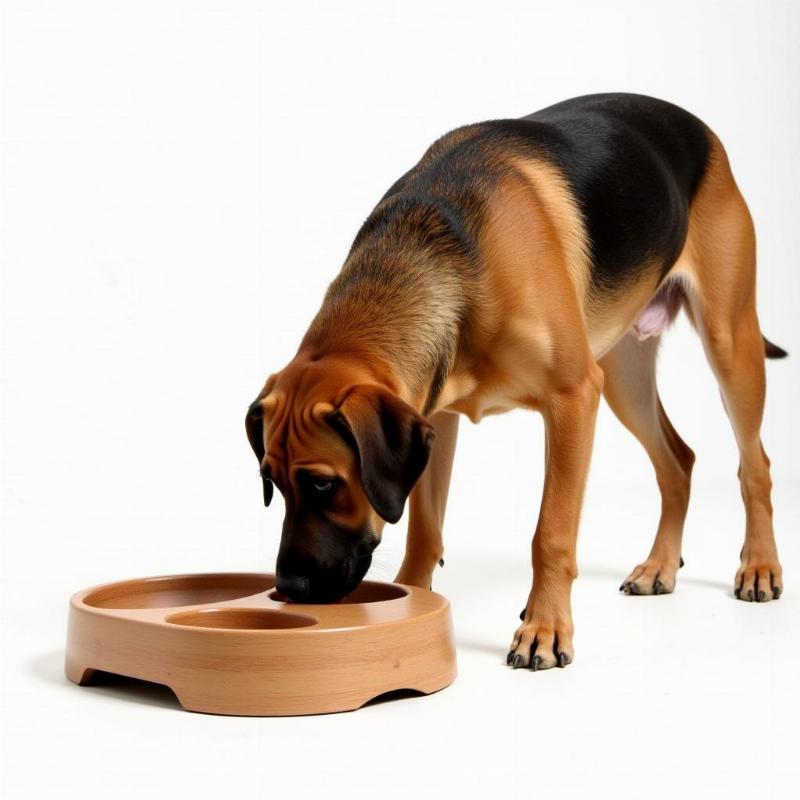Slow eating dog bowls are a game-changer for large breed dogs who tend to inhale their food. This can lead to a number of health issues, including bloating, vomiting, and even choking. Choosing the right slow feeder bowl for your large breed companion can significantly improve their mealtime experience and overall well-being. Let’s explore the world of slow eating dog bowls specifically designed for larger dogs and how to find the perfect one for your furry friend.
Why Your Large Dog Needs a Slow Feeder Bowl
Large dogs are notorious for gobbling down their food as quickly as possible. This rapid eating habit can be problematic, leading to digestive upset, choking hazards, and even a serious condition called Gastric Dilatation-Volvulus (GDV), commonly known as bloat. Slow feeder bowls, designed with various obstacles and ridges, force your dog to slow down and work for their kibble, promoting healthier eating habits.
Benefits of Slow Eating for Large Breeds
- Reduced Bloat Risk: Slowing down eating reduces the amount of air swallowed, a major contributor to bloat. This is especially crucial for large, deep-chested breeds like Great Danes, German Shepherds, and Standard Poodles who are more susceptible to GDV.
- Improved Digestion: Eating slowly allows for better food breakdown and nutrient absorption, reducing the chances of vomiting and digestive discomfort.
- Weight Management: By extending mealtime, slow feeders can help your dog feel fuller for longer, potentially aiding in weight management.
- Mental Stimulation: The puzzle-like design of slow feeders provides mental enrichment, keeping your dog engaged and entertained during mealtimes.
 Slow Feeder Bowl for a Large Dog
Slow Feeder Bowl for a Large Dog
Choosing the Right Slow Feeder for Your Large Dog
With so many options available, selecting the right slow feeder bowl can feel overwhelming. Consider these factors when shopping for your large breed companion:
- Size and Capacity: Ensure the bowl is large enough to accommodate your dog’s portion size without overflowing. A bowl that’s too small can frustrate your dog and negate the benefits of slow feeding.
- Material: Opt for durable, non-toxic materials like stainless steel or food-grade silicone. Avoid plastic bowls, which can be easily chewed and harbor bacteria.
- Design: Look for a design that challenges your dog without being too frustrating. Start with a simpler design if your dog is new to slow feeders.
- Ease of Cleaning: Choose a bowl that’s easy to clean, preferably dishwasher-safe.
Types of Slow Feeders for Large Dogs
- Ridged Bowls: These bowls feature raised ridges or patterns that create obstacles for your dog’s tongue.
- Maze Bowls: Maze bowls have more intricate designs, forcing your dog to navigate a maze-like pattern to reach their food.
- Puzzle Feeders: These interactive feeders combine slow feeding with puzzle-solving, providing a higher level of mental stimulation.
Transitioning Your Large Dog to a Slow Feeder
Introducing a slow feeder gradually will help your dog adjust to the new eating experience. Start by mixing a small amount of food in the slow feeder with the rest in their regular bowl. Gradually increase the proportion of food in the slow feeder until they are comfortable eating exclusively from it.
Tips for a Smooth Transition
- Positive Reinforcement: Praise and reward your dog during and after meals to create a positive association with the slow feeder.
- Patience: Some dogs adapt quickly, while others may take longer. Be patient and offer encouragement throughout the process.
- Supervision: Monitor your dog’s eating habits to ensure they are effectively using the slow feeder and not becoming frustrated.
Conclusion
Investing in a slow eating dog bowl is a valuable step towards improving your large dog’s health and well-being. By promoting slower eating habits, you can significantly reduce the risk of bloat, improve digestion, and even provide mental stimulation. Remember to consider your dog’s size, breed, and eating habits when selecting a slow feeder, and introduce it gradually to ensure a smooth transition. A slow feeder is a simple yet effective way to enhance your large dog’s mealtime experience and contribute to a healthier, happier life.
FAQ
- Are slow feeders suitable for all large dogs? Yes, slow feeders can benefit most large dogs, especially those prone to gulping their food.
- Can slow feeders help with weight loss? While not a guaranteed weight loss solution, slow feeders can help dogs feel fuller for longer, potentially aiding in weight management.
- How do I clean a slow feeder bowl? Most slow feeders are dishwasher-safe, making cleaning easy and convenient.
- What if my dog gets frustrated with the slow feeder? Try a simpler design or mix some food in their regular bowl to ease the transition.
- Can slow feeders prevent bloat completely? While slow feeders can significantly reduce the risk, they cannot guarantee complete prevention of bloat.
- Are there different sizes of slow feeders for large dogs? Yes, slow feeders come in various sizes to accommodate different breeds and portion sizes.
- What material is best for a slow feeder bowl? Stainless steel and food-grade silicone are durable and safe options.
Related Articles
- best dog food for great pyrenees
- best dog food for chow chow breed
- raised dog bowls with slow feeder
Beautdogs.us is your premier online resource for all things dog-related in the USA. We offer expert advice on dog breeds, care, and product recommendations. Whether you’re a seasoned dog owner or just starting your journey, Beautdogs.us provides comprehensive, trustworthy information to help you provide the best care for your furry companion. Contact us today for personalized support! Email: [email protected], Phone: +1 501-555-7529. Visit Beautdogs.us for more expert tips and product reviews!